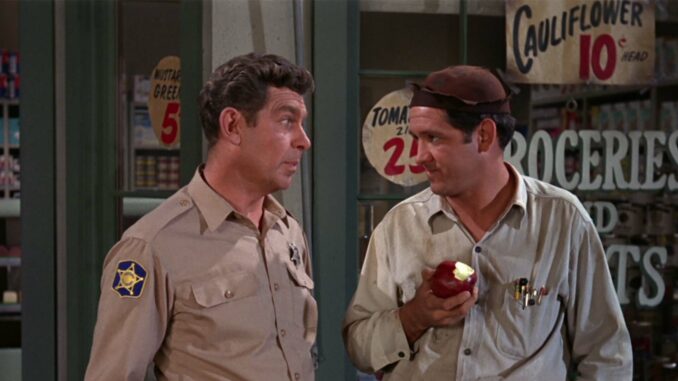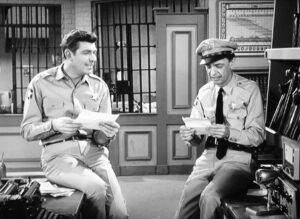
Introduction: A Different Kind of Star Power
What makes a leader truly great? On The Andy Griffith Show, Andy Griffith didn’t just play the wise sheriff of Mayberry—he embodied the role of a supportive team player off-screen. According to one of his co-stars, Griffith was “secure enough” to let his fellow cast members shine in their roles, and this approach was key to the show’s enduring success.
The Legacy of ‘The Andy Griffith Show’
A Peek into Mayberry’s Magic
From its debut in 1960, The Andy Griffith Show captivated audiences with its wholesome humor, charming characters, and life lessons. But what truly set the show apart was its unique dynamic among the cast.
Andy Griffith: More Than Just Sheriff Taylor
Griffith wasn’t just the lead actor; he was the glue that held Mayberry together. His calm, steady presence on and off the set helped foster an environment where everyone could thrive.

Andy Griffith’s Leadership Philosophy
‘Secure Enough’ to Step Back
One of Griffith’s co-stars revealed that his self-confidence allowed him to share the spotlight. Unlike some stars who hog the limelight, Griffith was comfortable stepping back to let others take center stage.
A Rising Tide Lifts All Boats
Griffith understood that the show’s success depended on the ensemble. By giving his co-stars room to shine, he elevated the entire production.
Supporting His Co-Stars’ Growth
Don Knotts as Barney Fife: A Star Is Born
Arguably, the biggest beneficiary of Griffith’s generosity was Don Knotts. Knotts’ portrayal of Barney Fife won him five Emmy Awards, thanks in part to the freedom Griffith gave him to fully develop the character.
Ron Howard’s Journey as Opie
Ron Howard, who played Opie, often spoke about Griffith’s mentorship. Griffith’s patient guidance helped Howard grow from a child actor to a respected director.
Frances Bavier as Aunt Bee
Even Frances Bavier, who played Aunt Bee, thrived under Griffith’s leadership. Despite their reported off-screen tensions, Griffith never let personal differences affect their professional relationship.
Behind-the-Scenes Dynamics
Fostering a Family Atmosphere
The set of The Andy Griffith Show felt more like a family gathering than a workplace. Griffith’s approachable demeanor made everyone feel valued and respected.
Encouraging Improvisation
Griffith’s flexibility allowed for improvisation, leading to some of the show’s most memorable moments. He trusted his co-stars to explore their characters and bring their own flair to the dialogue.
The Impact of Andy Griffith’s Approach
Creating Timeless Characters
From Barney Fife’s bumbling antics to Aunt Bee’s warm wisdom, every character felt authentic and well-rounded. This depth was a direct result of Griffith’s willingness to share the spotlight.
A Blueprint for Success in Television
Griffith’s leadership style became a model for other ensemble casts. His focus on collaboration over competition set a standard for future shows.

Why Andy Griffith’s Humility Still Matters
A Lesson in Leadership
In an industry often driven by ego, Griffith’s humility was refreshing. His actions proved that true leadership is about lifting others up, not just securing your own position.
The Power of Collective Success
Griffith’s philosophy reminds us that success is sweeter when shared. By empowering his co-stars, he ensured The Andy Griffith Show remained a beloved classic for generations.
Conclusion: A Star Who Let Others Shine
Andy Griffith’s secure and selfless leadership was the cornerstone of The Andy Griffith Show’s success. By allowing his co-stars to thrive, he created a show that was not just about one man but about a community. It’s a lesson in humility and collaboration that continues to resonate in the world of television and beyond.
FAQs
1. How did Andy Griffith’s leadership style influence his co-stars?
Andy Griffith’s supportive approach allowed his co-stars to fully explore and develop their characters, leading to more dynamic and memorable performances.
2. Why is Don Knotts’ role as Barney Fife so iconic?
Don Knotts’ performance as Barney Fife was both hilarious and heartfelt, made possible by Griffith’s trust in Knotts’ comedic instincts.
3. Did Andy Griffith and Frances Bavier have a good relationship?
While Griffith and Bavier had their differences off-screen, they maintained a professional relationship that never interfered with their performances.
4. How did Ron Howard benefit from working with Andy Griffith?
Ron Howard credits Griffith with teaching him valuable lessons about acting and storytelling, which helped him transition into a successful directing career.
5. What made The Andy Griffith Show stand out from other sitcoms?
Its emphasis on character development, moral lessons, and the collaborative dynamic of its cast set The Andy Griffith Show apart as a timeless classic.
